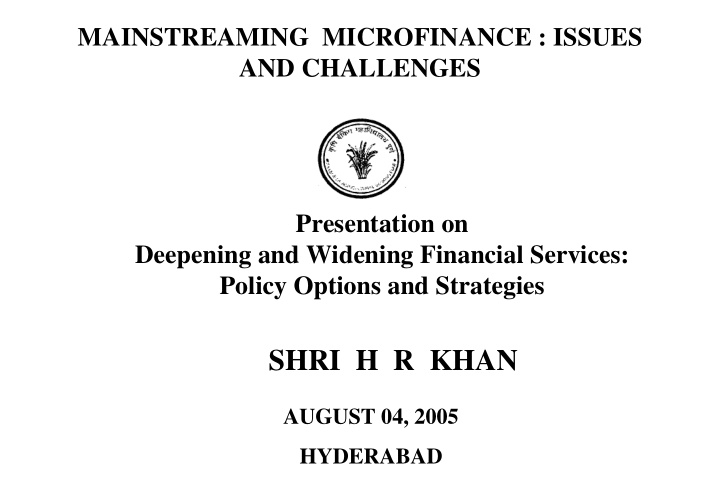



MAINSTREAMING MICROFINANCE : ISSUES AND CHALLENGES Presentation on Deepening and Widening Financial Services: Policy Options and Strategies SHRI H R KHAN AUGUST 04, 2005 HYDERABAD
Correspondent Banking Relationships – Role of MFIs • The coverage of population by formal financial sector is highly unsatisfactory • The anatomy of financial exclusion –The exclusion can be stated to be the function of both supply side and demand side drivers.
SUPPLY SIDE ANALYSIS a. persons are unbankable in the evaluation/perception of bankers, b. the loan amount is too small to invite attention of the bankers, c. the person is bankable on a credit appraisal approach but distances are too long for servicing and supporting the accounts and expanding branch network is not feasible and viable, d. high transaction costs particularly in dealing with a large number of small accounts,
SUPPLY SIDE ANALYSIS e. lack of collateral security, f. inability to evaluate and monitor cash flow cycles and repayment capacities due to information asymmetry, lack of data base and absence of credit history of people with small means, g. human resources related constraints both in terms of inadequacy of manpower and lack of proper orientation/expertise ,
SUPPLY SIDE ANALYSIS h. adverse security situation prevailing in some parts of rural India, i. lack of banking habits and credit culture, j. information-shadow geographical areas, and k. inadequacy of extension services which is crucial to improve the production efficiency of the farmers leading to better loan repayments.
DEMAND SIDE ANALYSIS a. high transaction costs at the client level due to expenses such as travel costs, wage losses, incidental expenses, b. documentation, c. lack of awareness, d. lack of social capital, e. non-availability of ideal products, f. very small volumes / size of transactions which are not encouraged by formal banking institutions,
DEMAND SIDE ANALYSIS g. hassles related to documentation and procedures in the formal system, h. easy availability of timely and doorstep services from money lenders/informal sources and i. prior experience of rejection by/indifference of the formal banking system.
THE LEARNINGS
SUPPLY SIDE i. Find ways and means for optimal use of available infrastructure and resources ii. Need to smoothening of adverse factors that pose hurdles to the philosophy of inclusion iii. Need to provide facilitating policy framework to achieve i and ii above.
DEMAND SIDE i. Recognise the need for specialisations to reach the unbanked. ii. Promote an institutional outreach framework to overcome the Demand and Supply side factors impeding expansion. iii. Build greater understanding of the needs and perspectives.
THE BASIC MODELS CLICK FOR MODELS
SUPPORT SYSTEMS 1. National Information Bureau for Micro Finance 2. Broad basing the Microfinance Development and Equity Fund 3. Development of Hardware and Software Technology for Rural Banking and Interphasing 4. Rural Banking Technology Development Fund, 5. Capacity building for Business Correspondents and Facilitators
SUPPORT SYSTEMS 6. Supportive Research and Evolution of best practices 7. Risk Analysis and Mitigation Strategies 8. Special focus and venture fund for North East 9. Standardisation of Rating, Credit Scoring and Accredition of Rating Agencies 10. Actively Promote and Accelerate existing Models.
Thank You hrkhan@rbi.org.in
Recommend
More recommend